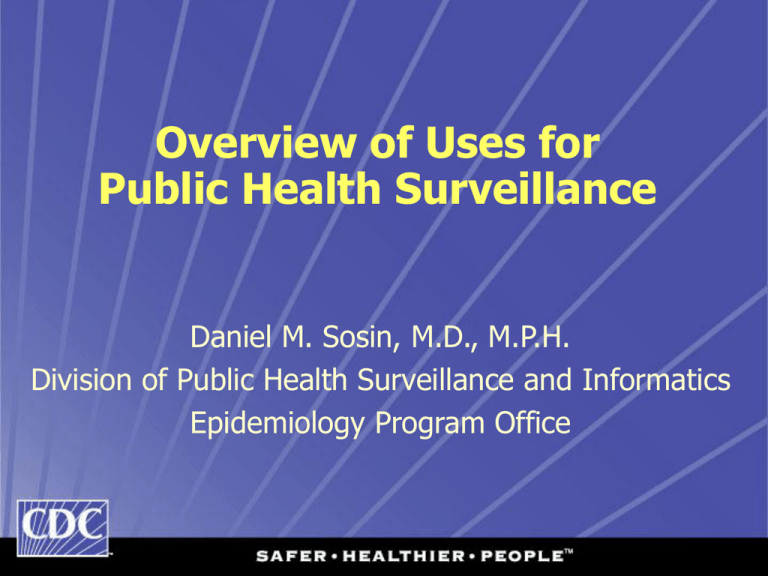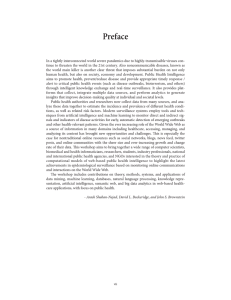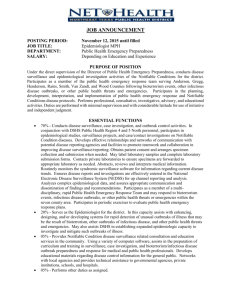Overview of Uses for Public Health Surveillance
advertisement

Overview of Uses for Public Health Surveillance Daniel M. Sosin, M.D., M.P.H. Division of Public Health Surveillance and Informatics Epidemiology Program Office Public Health Surveillance Ongoing, systematic collection, analysis, and interpretation of healthrelated data and dissemination for use in the planning, implementation, and evaluation of public health practice. Uses of Public Health Surveillance Estimate magnitude of the problem Portray the natural history of a disease Determine distribution and spread of illness Detect outbreaks Generate hypotheses, stimulate research Evaluate control and prevention measures Monitor changes in infectious agents Detect changes in health practices Facilitate planning Uses of Public Health Surveillance Estimate magnitude of the problem Portray the natural history of a disease Determine distribution and spread of illness Detect outbreaks Generate hypotheses, stimulate research Evaluate control measures Monitor changes in infectious agents Detect changes in health practices Facilitate planning Shigellosis 15 Reported cases per 100,000 population 1968-1998 10 5 0 1968 1973 1978 1983 1988 1993 Year Source: CDC. Summary of notifiable diseases. 1998. 1998 Uses of Public Health Surveillance Estimate magnitude of the problem Portray the natural history of a disease Determine distribution and spread of illness Detect outbreaks Generate hypotheses, stimulate research Evaluate control measures Monitor changes in infectious agents Detect changes in health practices Facilitate planning TOXIC SHOCK SYNDROME (TSS) United States, 1983-1998 16 0 National Center for Infectious Diseases (NCID) data* National Electronic Telecommunications System for Surveillance (NETSS) data Reported cases 14 0 12 0 10 0 8 0 6 0 4 0 2 0 0 1983 1984 1985 1986 1987 1988 1989 1990 1991 1992 Year (Quarter) 1993 1994 1995 1996 1997 1998 *Includes cases meeting the CDC definition for confirmed and probable cases for staphylococcal TSS. Uses of Public Health Surveillance Estimate magnitude of the problem Portray the natural history of a disease Determine distribution and spread of illness Detect outbreaks Generate hypotheses, stimulate research Evaluate control measures Monitor changes in infectious agents Detect changes in health practices Facilitate planning Rate of Hepatitis A United States, 1998 NYC DC PR NA VI GUAM NA AM SAMOA NA CNMI < 5.0 5.0–9.9 10.0–19.9 >20.0 Source: CDC. Summary of notifiable diseases. 1998. Uses of Public Health Surveillance Estimate magnitude of the problem Portray the natural history of a disease Determine distribution and spread of illness Detect outbreaks Generate hypotheses, stimulate research Evaluate control measures Monitor changes in infectious agents Detect changes in health practices Facilitate planning Botulism (Foodborne) United States, 1978-1998 110 100 Reported cases 90 80 Outbreak caused by potato salad, NM Outbreak caused by sautéed onions, IL Outbreak caused by fermented fish/sea products, AK 70 Laboratory-confirmed cases* NETSS data Outbreak caused by baked potatoes, TX 60 50 40 30 20 10 0 1978 1983 1988 1993 Year 1998 Source: CDC. Summary of notifiable diseases. 1998. *Data from survey of state epidemiologists and directors of state public health laboratories. Not yet available for 1998. Uses of Public Health Surveillance Estimate magnitude of the problem Portray the natural history of a disease Determine distribution and spread of illness Detect outbreaks Generate hypotheses, stimulate research Evaluate control measures Monitor changes in infectious agents Detect changes in health practices Facilitate planning MEASLES (Rubeola) United States, 1963-1998 500 MEASLES — by year, United States, 1983– 1998 Vaccine licensed 30 450 25 400 Reported Cases (Thousands) 20 15 350 10 Reported cases (thousands) 300 250 5 0 1983 1988 1993 1998 Year 200 150 100 50 0 1963 1968 1973 1978 1983 Year 1988 1993 1998 Source: CDC. Summary of notifiable diseases. 1998. Uses of Public Health Surveillance Estimate magnitude of the problem Portray the natural history of a disease Determine distribution and spread of illness Detect outbreaks Generate hypotheses, stimulate research Evaluate control measures Monitor changes in infectious agents Detect changes in health practices Facilitate planning Poliomyelitis (Paralytic) United States, 1968-1998 60 Rate/100,000 Population 55 50 Reported cases 45 40 35 30 25 1000 100 10 Inactivated Vaccine Oral Vaccine 1 0.1 0.01 0.001 1951 1956 1961 1966 1971 1976 1981 1986 1991 1996 Year 20 15 10 5 0 1968 Year 1973 1978 1983 1988 1993 1998 NOTE: Inactivated vaccine was licensed in 1955. Oral vaccine was licensed in 1961. Source: CDC. Summary of notifiable diseases. 1998. Uses of Public Health Surveillance Estimate magnitude of the problem Portray the natural history of a disease Determine distribution and spread of illness Detect outbreaks Generate hypotheses, stimulate research Evaluate control measures Monitor changes in infectious agents Detect changes in health practices Facilitate planning Trends in Plasmid-Mediated Resistance to Penicillin and Tetracycline United States, 1988-1997 12 PPNG TRNG 10 PPNG & TRNG Percent 8 Source: Gonococcal Isolate Surveillance Project (GISP) 6 4 2 0 1988 1989 1990 1991 1992 1993 1994 1995 1996 1997 Year Note: "PPNG" (penicillinase-producing ) and "TRNG" (tetracycline-resistant) N. gonorrhoeae refer to plasmidmediated resistance to penicillin and tetracycline, respectively. Uses of Public Health Surveillance Estimate magnitude of the problem Portray the natural history of a disease Determine distribution and spread of illness Detect outbreaks Generate hypotheses, stimulate research Evaluate control measures Monitor changes in infectious agents Detect changes in health practices Facilitate planning Breast Cancer Screening Uses of Public Health Surveillance Estimate magnitude of the problem Portray the natural history of a disease Determine distribution and spread of illness Detect outbreaks Generate hypotheses, stimulate research Evaluate control measures Monitor changes in infectious agents Detect changes in health practices Facilitate planning Tuberculosis United States, 1986-1998 (U.S.- and foreign-born persons) 20,000 Reported cases U.S.-born Foreign-born 16,000 12,000 8,000 4,000 Year 0 1986 1987 1988 1989 1990 1991 1992 1993 1994 1995 1996 1997 1998 Uses of Public Health Surveillance Estimate magnitude of the problem Portray the natural history of a disease Determine distribution and spread of illness Detect outbreaks Generate hypotheses, stimulate research Evaluate control and prevention measures Monitor changes in infectious agents Detect changes in health practices Facilitate planning Surveillance for Outbreak Detection Convergence of technology, volumes of electronic data, and new priority for early detection Increase timeliness and completeness of routine data Capture nontraditional data that signify a condition before a diagnosis is made Analytic methods to detect smaller signals Surveillance for Outbreak Detection: Experience Laboratory specificity to detect clusters Sentinel systems with resources to monitor and investigate Syndrome surveillance where outbreaks are substantial and predictable Case reports trigger outbreak investigation Surveillance for Outbreak Detection: Exploration Enhanced reporting from clinical sites (ED, EMS, 911, offices) Health care transaction warehouses (pharmacy, patient encounters, lab orders) Novel data sources (retail sales, veterinary encounters, environmental indicators, absenteeism) Signal detection methods Surveillance for Outbreak Detection: Reality Human “technology” is key Single case detection depends on clinical acumen and reporting relationships Epidemiologic judgment in evaluating volumes of data Follow-up of system signals Tolerance for false alarms will vary Surveillance Research Needs Achieving the National Electronic Disease Surveillance System (NEDSS) architecture Data fusion (linkage) New data sources Case definitions (automation/validation) Geographic Information System (GIS) indices Forecasting Evaluation and quality control Resources www.cdc.gov/cic www.cdc.gov/epo/dphsi/phs.htm www.cdc.gov/epo/dphsi/phs/syndromic.htm dsosin@cdc.gov


